Good day! Baybayin (ᜊᜊᜌᜒ; ᜊᜌ᜔ᜊᜌᜒᜈ᜔) is an ancient writing system in the Philippines which was used way before it was colonized by the Spaniards. Baybayin means “to spell” and it is an abugida or alphasyllabary.
So for today we will learn how to read and write the Baybayin!
Just a little bit of background, Abugida or alphasyllabary is a set of symbols that represents the syllables or mora of a word. The ending vowel sound of a consonant character can be change by the use of a diacritic. This is different from an alphabet which is a set of letters that make up a syllable or word. It is kind of similar to a syllabary except that in a syllabary, the ending vowel sounds do not change by adding a diacritic instead a different character is used like in Japan’s Kana systems. Baybayin is also known as Alibata, though Baybayin communities rejected this name.
Let’s start! There are two ways to write Baybayin: the Traditional way and the Reformed way. The Traditional way of writing is how our ancestors wrote and read Baybayin. Our ancestors are experts in this. On the other hand, the Spaniards were having a hard time with it, so they, or should I say, a Spanish priest introduced the Reformed way of writing Baybayin.
Below is a chart of the original and traditional Baybayin that is used by our ancestors. Kindly click/tap the image to view in HD quality.
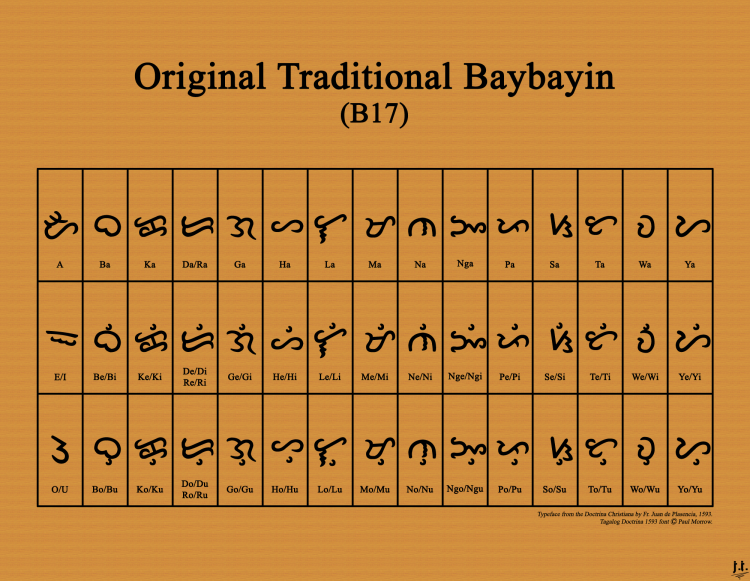
The Rule
Writing Baybayin is actually pretty easy to learn. You just need to remember this rule:
“Spell it the way you say it.”
Baybayin
Vowels
There are only three vowels in Baybayin.
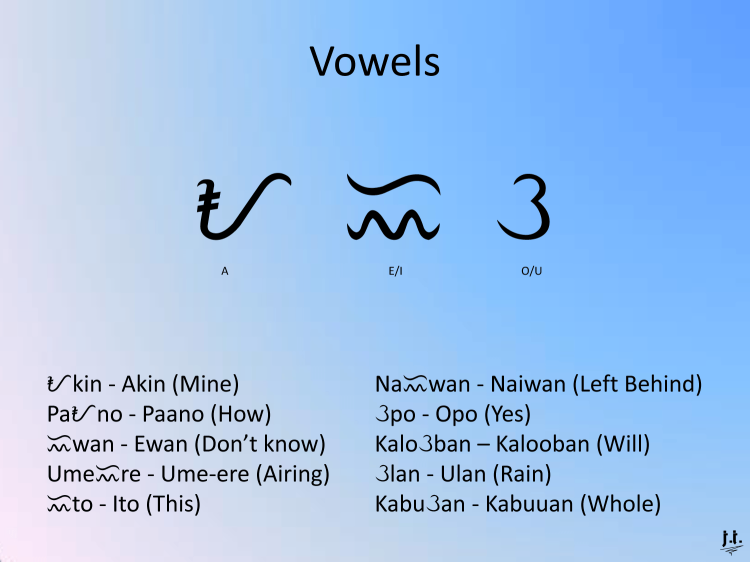
You might be wondering why E and I; and O and U are the same. In old Tagalog, E and I as well as O and U are allophones. In fact, some of the modern Filipino words today still retain this allophone like lalaki/lalake (man) and manood/manuod (watch) to mention a few.
Consonants

All the consonants without a diacritic have an ending “A” sound. Should you wish to change the ending vowel sound to either an “E/I” or “O/U” simply use a diacritic which is called Kudlit (line/apostrophe). The shape of the diacritic does not matter; it can either be a small dot, circle, tick, apostrophe, line, arrowhead, etc. However, the position of the kudlit is very important. As you may notice from the chart above, if the kudlit is placed above the character, then the ending vowel sound changes to “E/I”.
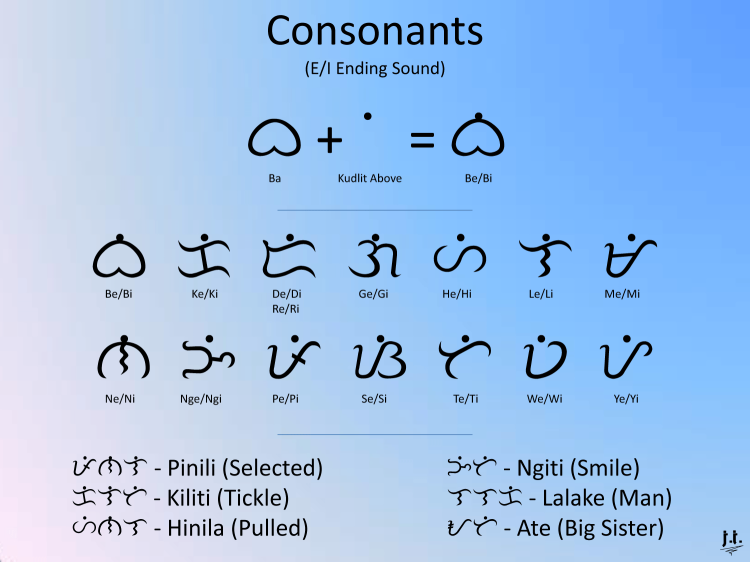
And it changes to “O/U” if the kudlit is placed below.

You may also notice that the character for Da and Ra are the same. This is because Da and Ra are also allophones in old Tagalog and Filipino. For example: dito/rito (here), doon/roon (there), and dinig/rinig (hear) among any other.
Another interesting thing to take note is the consonant “NGA”. If you are a Filipino or if this sound is present in your local language; then you should already be familiar with this sound. However, for those unfamiliar with this sound, the “Nga” is similar to the Latin letter Eng “Ŋ” (lowercase “ŋ”) but with an ending “A” sound. You can hear the ‘eng’ sound in the English word sing and singing. In phonetics, this is categorized as a velar nasal consonant. In Baybayin, “Nga” has its own dedicated character.
The Traditional Way and The Final Consonants
The Traditional way of writing is also commonly known as B17 within the Baybayin community. B17 stands for Baybayin 17 as there are 17 characters: three vowels (A, E/I, and O/U), and 14 consonants (BA, KA, DA/RA, GA, HA, LA, MA, NA, NGA, PA, SA, TA, WA, YA) as you can see from the chart above.
I mentioned earlier that writing Baybayin is very easy, however, reading it in traditional way is a different story and I have to admit that it is quite difficult to read Traditional Baybayin. This is because of the final consonants.
In Traditional Baybayin, the final consonant(s) of a syllable and word are dropped when writing as there are no characters for consonant alone. However, the dropped final consonants magically reappears when read. Our ancestors are very comfortable and are already expert in this. For example: pagmamahal (love/affection), bahay (house) and kulog (thunder) are spelled as:
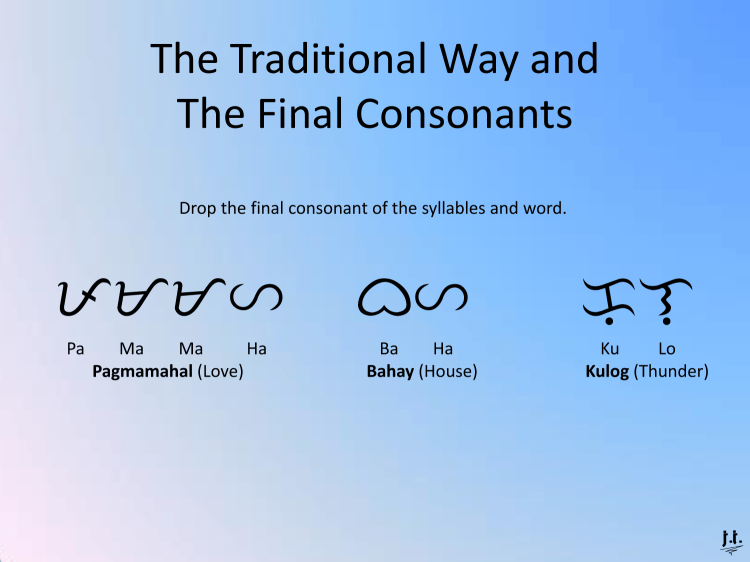
This is really confusing as many words can be spelled the same way. For example: bansa (country), bagsak (fall), basa (read), and basag (broken) can all be spelled as:
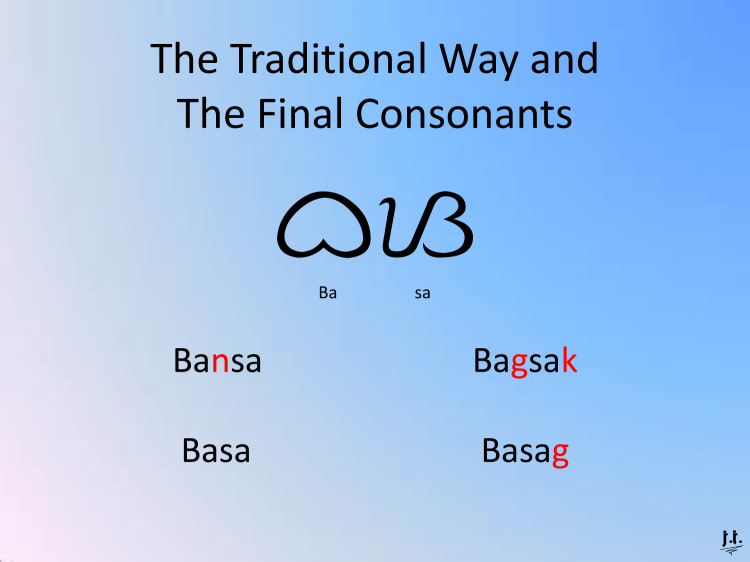
The amazing part is that our ancestors can understand this way of writing and reading with ease.
The Reformed Way and The Virama (Vowel Killer)
Because of the final consonants scenario above, a Spanish friar, Fr. Francisco Lopez, introduced the vowel killer or virama diacritic in the form of a little cross that is placed below the character. The little cross is a reference to Christianity. This new kudlit is called Krus-kudlit or Sabat and it cancels the default ending “A” sound of a consonant.

With this, it is now possible to write the final consonant of a syllable and word. And the pagmamahal (love/affection), bahay (house) and kulog (thunder) above can now be spelled with final consonants.
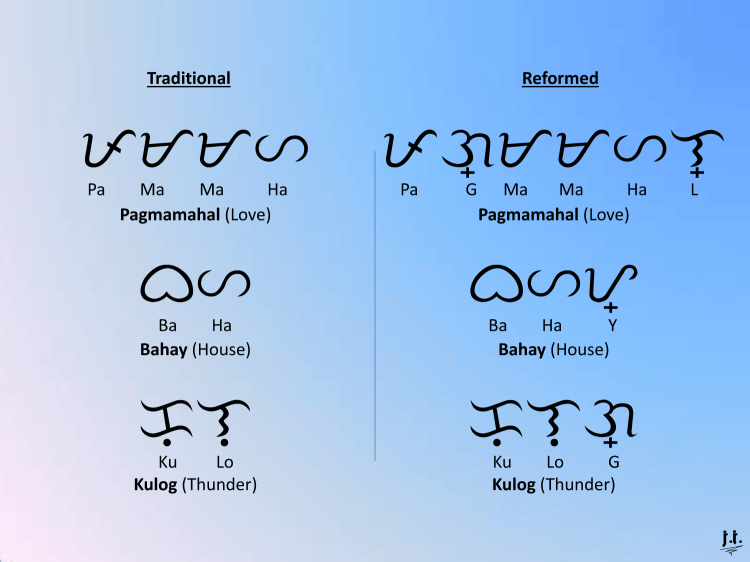
This is known as the 1620 Spanish Reformed way of writing Baybayin or what the Baybayin community commonly calls B17+ (The “+” indicating the addition of the virama). Though this might be taught to and used by some of our ancestors, this however, was not fully accepted by our ancestors as they felt that this is against their belief that Baybayin is a sacred script bestowed upon them.
This way of writing, however, is now very popular to the modern community. Below is a chart of the 1620 Reformed Baybayin. Kindly click/tap the image to view it in HD quality.
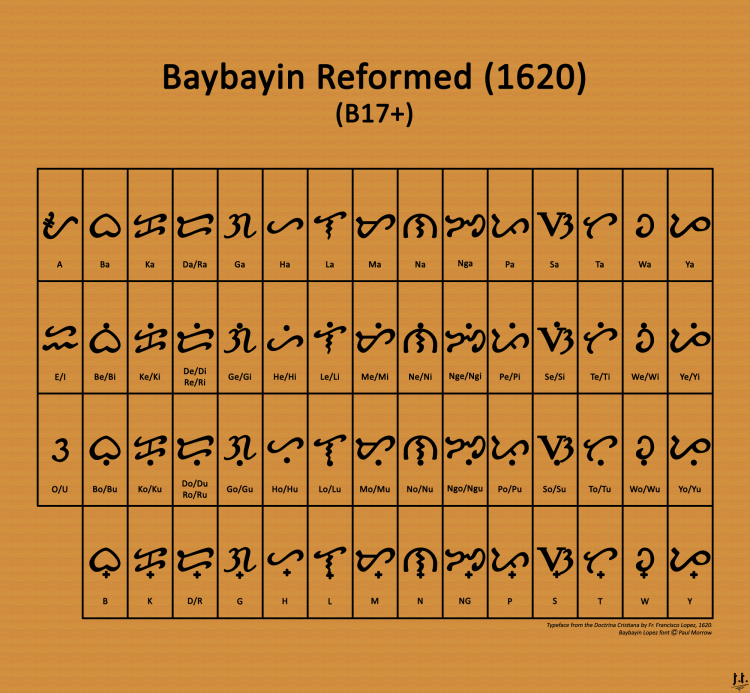
The Word “Ng” and “Mga”
In Filipino, “ng” (pronounced as “nang”) is a preposition that can be translated to “of” in English depending on the context; and “mga” (pronounced as “ma-nga”) is an article that pluralizes the noun following it. Base on the rule of Baybayin above, “ng” should be spelled as ᜈ (“na” in traditional) and ᜈᜅ᜔ (“nang” in reformed); and “mga” should be spelled as ᜋᜅ (ma-nga).
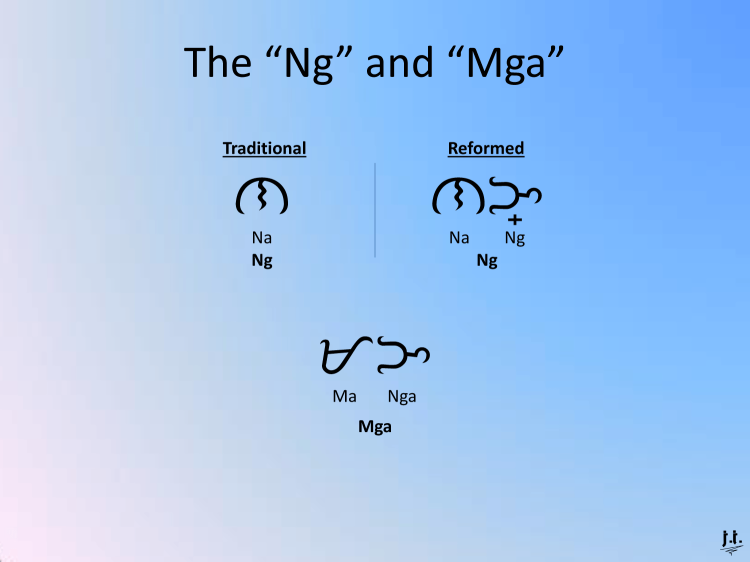
Initial Consonant Cluster
Consonant cluster is not native to Filipino language and is only present in loanwords. To write syllables that start with a consonant cluster in the traditional way, simply separate the consonants and insert a vowel. This can be seen in the 1593 Doctriana Christiana where Christo (Kristo “Christ”) was spelled as ᜃᜒᜇᜒᜆᜓ (Kirito). In the reformed way, you can simply use the virama krus-kudlit.
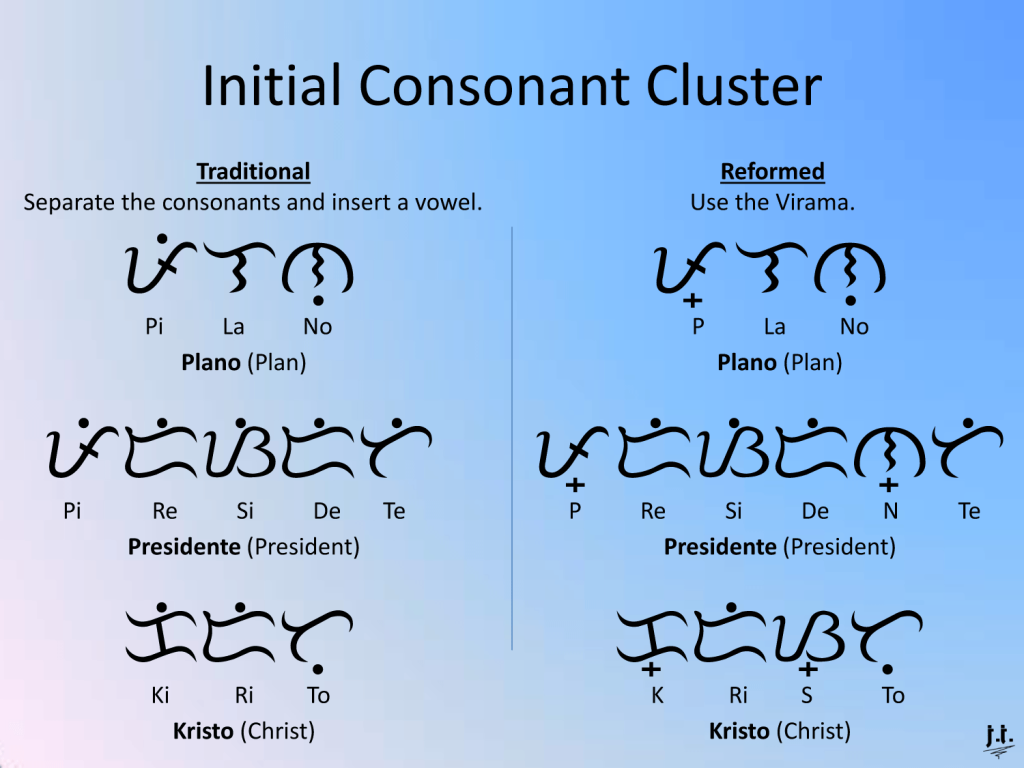
Diphthongs
Diphthongs in native Filipino always end in “W” or “Y”; simply drop the final “W” or “Y” in traditional writing and just use the virama in the reformed way. For loanwords or diphthongs that are spelled with two vowels, (e.g., Mindanao, India, Bautista), simply change the second vowel sound to either “W” or “Y” depending on the pronunciation (e.g., Mindanaw, Indiya, Bawtista).
Please take note that single vowel characters in Baybayin are pronounced individually. Trying to use two Baybayin vowel characters for diphthongs will result to a hiatus (two vowels next to each other that are pronounced individually) instead (e.g., Mindana-O, Indi-Ah, Ba-Uh-tista). Just remember, spell it the way you say it.

Hyphen
Baybayin do not have hyphen as it is an abugida with the single vowel characters pronounced individually. Hyphens are also dropped for hyphenated compound words like abot-kamay (within reach).

Punctuation and Spacing
Word spacing is not present in the traditional way of writing and the only punctuation mark used is in the form of a double vertical bar which is called Bantasan (᜶). This acts as a comma, period or full stop, question mark and sometimes separates words. Today, word spacing is being used and there are already two punctuation marks: a single vertical bar that acts as a comma (᜵) and the original bantasan (᜶).
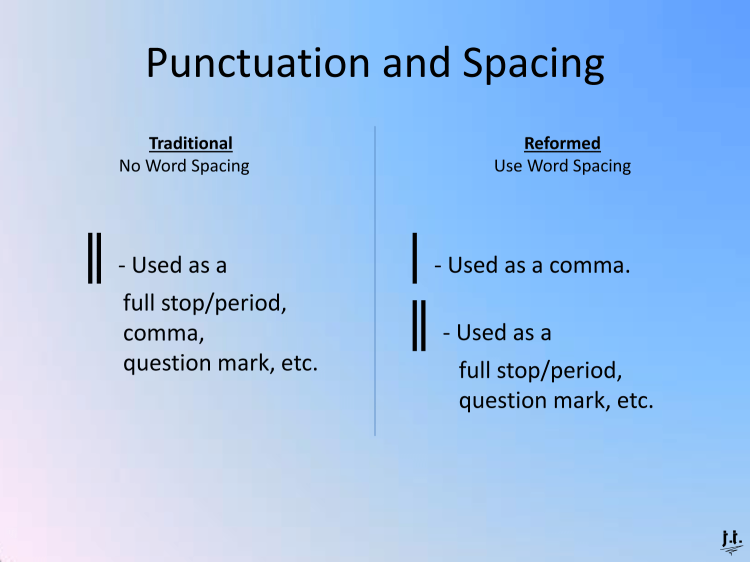
Foreign Sounds
Foreign sounds or letters like C, Ch, F, J, Ll, Ñ, Q, Sh, Th, V, X and Z can be written by compounding characters or via allophones. Just remember the rule to spell it the way you say it.
- C (like in cake) – Use “Ka” characters.
- C (like in center) – Use “Sa” characters.
- Ch (like in chance) – Use a combination of “Ti” (Traditional)/“T” (Reformed) and a “Ya” or “Sa” character.
- F – Use “Pa” characters.
- J (like in Juan) – Use “Ha” characters.
- J (like in John) – Use a combination of “Di” (Traditional)/“D” (Reformed) and a “Ya” character.
- Ll – Use either “Ya” or compounded “Ja” characters depending on the pronunciation.
- Ll (like in Llamzon) – Use a combination of “Li” (Traditional)/“L” (Reformed) and a “Ya” character.
- Ñ – Use a combination of “Ni” (Traditional)/“N” (Reformed) and a “Ya” character.
- Q (like in Qatar) – Use “Ka” characters.
- Q (like in Queen) – Use a combination of “Ku” (Traditional)/“K” (Reformed) and a “Wa” character.
- Sh (like in ship) – Use a combination of “Si” (Traditional)/“S” (Reformed) and a “Ya” character.
- Th – Use either “Da” or “Ta” characters depending on the pronunciation.
- V – Use “Ba” characters.
- X (like the ‘xe’ in xerox) – Use “Sa” characters.
- X (like in Roxas) – Use “Ha” characters.
- X (like in boxing) – Use a combination of “Ki” (Traditional)/“K” (Reformed) and a “Sa” character.
- X (like in exact) – Use a combination of “Gi” (Traditional)/“G” (Reformed) and a “Sa” character.
- Z – Use “Sa” characters.
Suggested Modern Baybayins
A lot of suggestions and proposals were made to modernize the Baybayin, there are now the B18, B18+ and so on. These versions added characters to accommodate loanwords and foreign words. However, the government have yet to release any statement regarding these. I have explained some of the modern Baybayin versions in another post at Versions of Baybayin.
We also have a modern Baybayin called Modern Baybayin 17+ (MB17+). This preserves the original 17 characters and instead of adding new characters, diacritics are added to accommodate loanwords and foreign words making it practical and easy to use and memorize. You can read more about it here at Modern Baybayin (MB17+).
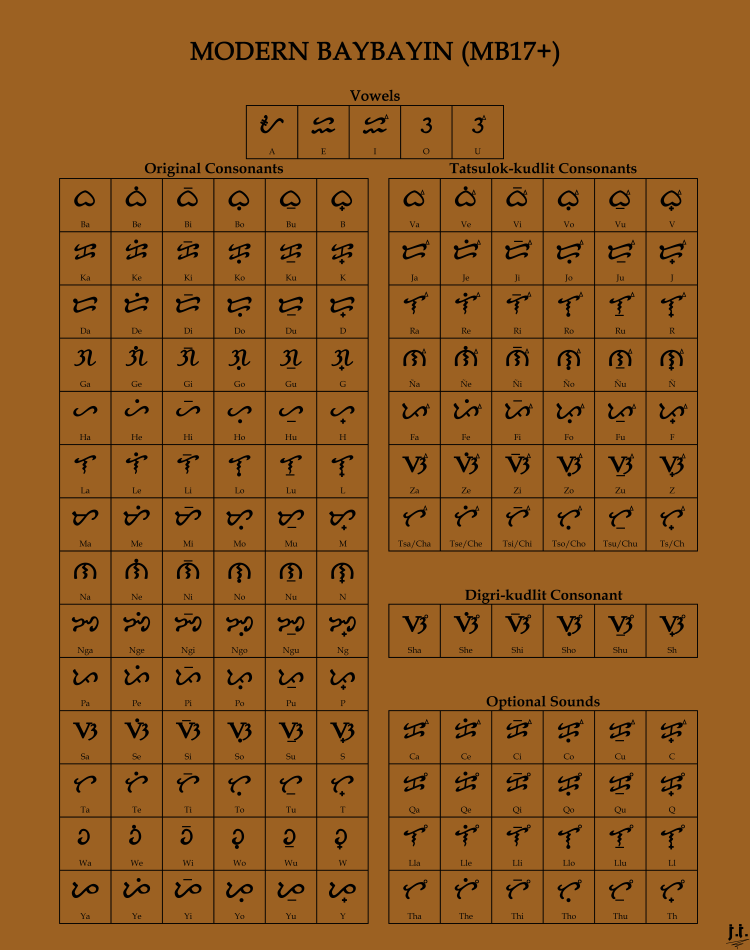
To Review
- “Kung ano ang bigkas siyang baybay.” (Spell it the way you say it.)
- In traditional writing, drop the final consonants.
- In traditional writing, separate the consonants and insert a vowel in between if the syllable starts with a consonant cluster.
- In the reformed way, use a virama or vowel killer for final consonants and consonant cluster.
- Don’t use vowel characters for diphthongs.
- Drop the hyphen.
- And lastly, enjoy and just have fun! 😊
I hope I was able to help you learn Baybayin. If you have any additional questions, please do not hesitate to ask in the comment section below. ᜋᜇᜋᜒ ᜐᜎᜋ! / ᜋᜇᜋᜒᜅ᜔ ᜐᜎᜋᜆ᜔! God Bless =>
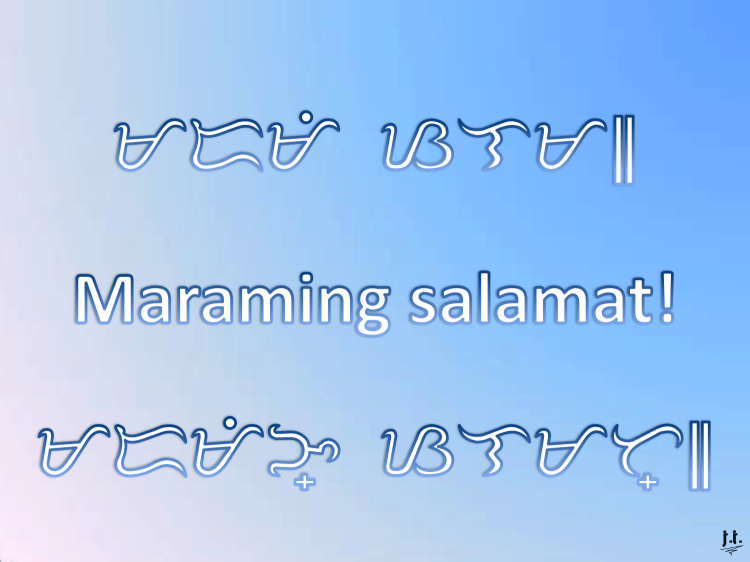

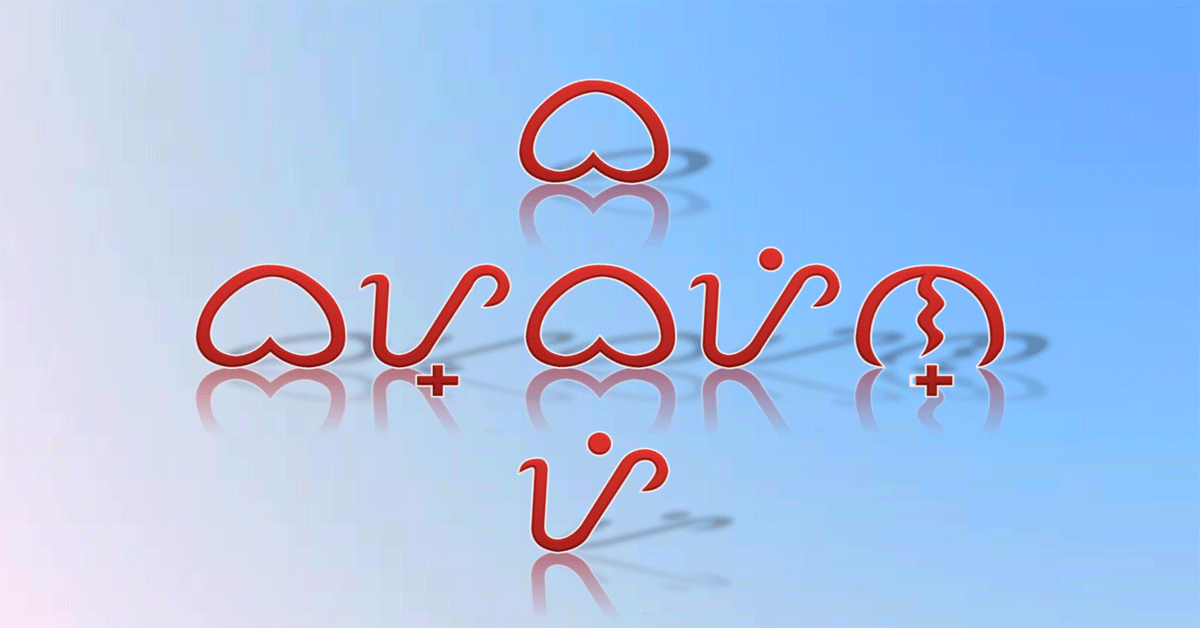
KA-E-L = ganyan po ba tamang baybay? Ipapa-tatts ko po sana
LikeLike
Pa convert nmn s baybayin mga name..ipa2tattoo ko po kase..salamat po
kathryn
Nathaniel
Eldrich
Erich
Joel
LikeLike